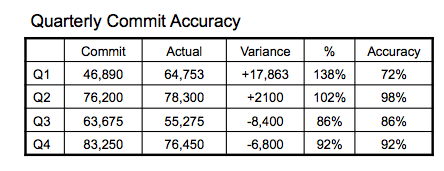We measure a lot of things in sales. Some sales organizations are fanatical about metrics, others not so much. Either way, measurement is part of sales. It’s what makes sales such a unique monster. There is no place to hide. Sales is an objective environment.
With all the measuring sales does, there has been one measurement that rarely shows up on our dashboards. What makes it unique is, it is one of the very few measurements that is a leading indicator. It’s not hard to track. It provides tremendous visibility into the capabilities and skills of the sales team and it doesn’t require CRM or some cumbersome process. What wonderful metric are we missing that does all that? — Forecasting accuracy.
It’s not uncommon for companies to manage the forecast. At the beginning of the quarter everyone provides their monthly and quarterly numbers and then at the end of month and quarter the numbers have been hit or not. If the numbers have been exceeded everyone is thrilled. It the numbers are missed everyone is freaked out. Forecasting, unto itself is very common. What’s missing with most organizations is the accuracy component. In other words, few organizations measure forecasting accuracy throughout the year or how accurate their individual reps and sales leaders are in forecasting their sales numbers.
Why should accuracy matter?
I’ll answer that question with a question. How valuable would it be to you as the head of sales, the CEO, COO, V.P. of sales etc, to know within 95% accuracy, EXACTLY what the team is going to sell every month and quarter? How valuable would it be to know which sales reps are consistently 98% accurately forecasting their number and which reps never seem to be able to be anymore accurate than 80%?
Having the ability to accurately and consistently forecast is a key sales requirement. It ensures the sales people have strong grasp on what is happening in the sales cycle, how they are going to bring in a deal and when. Accurate forecasting removes the “thumb in the air” forecasting most organizations are subject to.
This is how I track forecasting accuracy by quarter:

This is for a team. I also track by individual rep this way. The goal for most organizations is to be with in 5-10% accurate on either side of the commit number. I encourage my clients to measure accuracy by quarter and by month. At the beginning of each quarter, each sales rep is required to give their manager a monthly and quarterly “Day 1” commit. The Day 1 commit is what the final accuracy number is generated from. The managers then role up their commit, the VP’s etc. The goal is for each layer in the organization to consistently meet the accuracy numbers monthly and quarterly.
Holding sales people accountable to what they’re going to do each month and quarter minimizes the vicious swings sales organizations are prone to. It provides an accurate, forward looking indicator. When accuracy is being measured, exceeding the number is just as bad as missing it. Sandbagging is no longer possible. Sales people become more engaged in their business. They focus more on the trends and the buying habits of their customers. Sales reps understand if they don’t, they won’t be able to accurately forecast. They will miss their commit and missing commit is not OK.
Having an accurate, leading indicator like forecasted revenue is gold. Yet, few companies have it, fewer track it, and even fewer hold their sales teams accountable to it.
How accurate are your sales forecasts? Do you know who the most accurate sales reps are? You should, they know their business.


